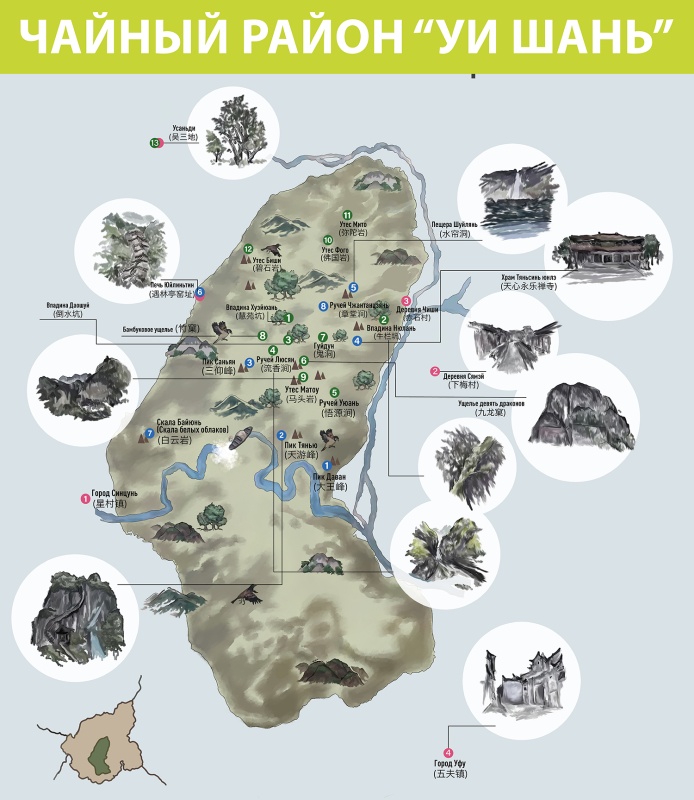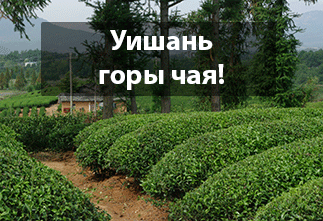Zhougui Nong Xiang: Deep Roasted Cinnamon – The Treasure of Wuyi Shan
Rougui Nong Xiang (Chinese: 武夷肉桂, pinyin: wǔyí ròuguì) is a special type of oolong tea that comes from the Fujian Province of China, more specifically from the Wuyi Mountains. Its name translates as "fleshy cinnamon with a strong aroma," and it fully reflects the character of this tea. Origin: Wuyi Mountains (Chinese: 武夷山, pinyin: wǔyíshān), Fujian Province (Chinese: 福建, pinyin: fújiàn), China.
This cliff oolong got its name for its rich aroma, similar to the smell of brown wood. The plantations where Zhougui is grown are located in the central part of the Wuyishan Nature Reserve, where the soil is rich in minerals and the steep cliffs are washed by mountain streams.
The best harvest is considered to be the one collected in spring and left until autumn. The Chinese believe that processed tea should rest so that the "qi" of fire leaves the tea leaf. Thanks to this, the tea turns out soft and aromatic.
The manufacturing process begins with drying in the open air, then the leaves are crushed until the juice is released, which allows the fermentation to speed up. After this, the raw material is allowed to rest and be saturated with oxygen. The process is completed by roasting in hot boilers and final drying over coals.
Zhou Gui is a tea with a centuries-old history. Long before the Qing Dynasty, it was a favorite drink of Taoist and Buddhist monks. According to legend, a Taoist named Tsung Zi Po discovered a tea bush near the cave of his teacher, in which he meditated, and then passed into another form of existence. Considering this find as a gift from above from the teacher, the Taoist transplanted this tea bush to the temple grounds. Thus, Zhou Gui came to the Buddhists, and then to local farmers.
What makes Zhougui Nong Xiang special?
- Deep Roast: Thanks to the unique processing technology, the tea acquires a rich, deep aroma with pronounced notes of cinnamon, toasted bread and even light fruity tones.
- Mild Taste: Despite being heavily roasted, the taste of Rougui Nong Xiang is surprisingly soft and rounded, with a pleasant aftertaste.
- Versatility: This tea opens up gradually, revealing new facets of its taste and aroma with each new infusion.
- Health Benefits: Like many other oolongs, Zhougui Nong Xiang is rich in antioxidants, vitamins and minerals. It helps improve digestion, boost immunity and relieve stress.
How to brew Zhougui Nong Xiang?
To fully utilize the potential of this tea, it is recommended to use the following guidelines:
- Water temperature: 95-100°C
- Amount of tea: 5-7 grams per brew
- Brewing time: First brew – 30 seconds, subsequent brews – 10-15 seconds longer.
- Utensils: Gaiwan or small clay teapot.
What goes well with Rougui Nong Xiang?
Zhougui Nong Xiang goes well with various desserts, fruits and nuts. It can be drunk neat or with honey or lemongrass. This tea is also great for meditation and relaxation.
Zhougui Nong Xiang is not just a drink, it is a real treasure of Chinese tea culture . Its rich taste and aroma will not leave any tea connoisseur indifferent.
From the first cup, the tension goes away, a light and joyful state appears with a long sweetish-spicy aftertaste.
According to Chinese medicine, it has been established that Zhou Gui is useful for the lungs and circulatory system. It has a complex effect on the body, increases efficiency and increases human energy. With regular use, mood noticeably improves, stress is relieved, blood pressure is normalized and all protective functions of the body are strengthened.
|
Name in Chinese
|
浓香肉桂 |
|
Pinyin
|
ròuguì |
|
English name
|
Zhougui Nun Xiang |
|
Translation
|
Cinnamon |
|
Tea variety
|
Wu Yi Ro Gui |
|
Country
|
China |
|
District
|
Wuyishan |
|
Provinces
|
Fujian (福建) |
|
Habitat
|
Уишань Баньян (武夷山半岩) |
- Комментарии
- Вконтакте
The Wuyi Mountains, and shan, as is known, is translated as "mountain" or "mountains", are located on the border of the provinces of Fujian and Jiangxi. This is a mountain range located on an area of about 1000 square kilometers. The highest point is Mount Huanggangshan, 2158 meters high, which is included in the UNESCO World Cultural Heritage, both for cultural and natural criteria.



















































































